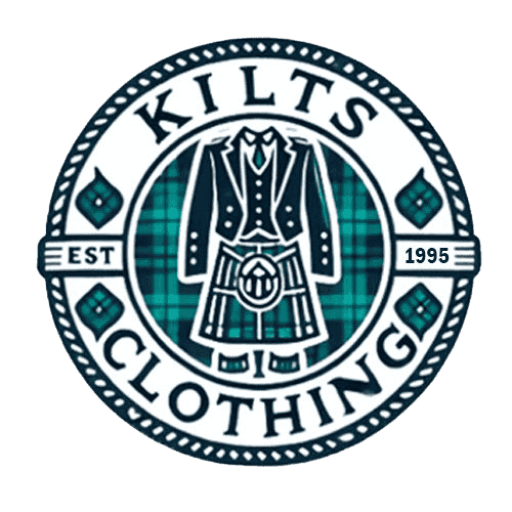Why Don’t You Wear Anything Under a Kilt?

When you think of kilts, one of the first questions that might come to mind is, "Why don't you wear anything under a kilt?" This question has been asked by many, especially those who are unfamiliar with Scottish tradition or the historical significance of this iconic garment. For many, it's an unusual practice. Still, for others, it's a proud and respected tradition with roots going deep into Scottish culture.
In this blog, we'll explore the history, reasons, and cultural significance behind the practice of not wearing anything underneath a kilt. Let's unravel the mystery and discover why this tradition has lasted for centuries.
The History Behind the Tradition
Origins of the Kilt
The origins of the kilt can be traced back to the Scottish Highlands in the 16th century. However, its design and usage evolved significantly over time. The kilt, in its early form, was a large piece of cloth known as the feileadh mòr, or "great kilt." This garment was essentially a long, rectangular piece of woolen cloth that could be draped around the body. It was fastened at the waist with a belt and could be used as a blanket when needed.
This garment was practical in the harsh, cold climate of the Scottish Highlands, providing warmth and versatility. The early Scots wore their kilts for both functionality and comfort, as well as for identification. Different tartans (the distinctive patterns) represented various Scottish clans, allowing individuals to identify each other by family or clan heritage.
Practicality in the Highlands
In the rugged Scottish Highlands, practicality was paramount. The climate and terrain demanded clothing that was both functional and comfortable. The kilt, made of wool, provided warmth and protection against the elements. But in those days, men didn't wear undergarments the way we do today. The design of the kilt was such that it provided all the necessary coverage, making underwear unnecessary.
In addition to its practicality, the kilt also gave the wearer freedom of movement, which was essential for Highlanders who worked as farmers, hunters, and soldiers. The pleated design allowed for better mobility when walking, climbing, or riding horses. So, when you think about it from a practical perspective, wearing anything under a kilt wasn't necessary – the garment was designed to function as a complete piece of clothing on its own.
The “No Underwear” Tradition Explained
The Tartan and Its Use
One of the key aspects of wearing a kilt is its distinctive tartan pattern. Traditionally, the tartan signified the wearer’s clan or family. These patterns were woven into the fabric, and each design represented a different region or family in Scotland.
The kilt was not just a functional garment but also a symbol of pride and heritage. Its design was such that it provided full coverage, so the need for additional undergarments wasn’t necessary. The fabric itself was draped around the waist and secured with a belt, allowing for comfort and ease of movement. Over time, the tradition of not wearing anything underneath the kilt became embedded in Scottish culture, symbolizing masculinity, freedom, and a connection to the land.
Freedom of Movement
One of the most significant reasons people historically did not wear anything underneath their kilts was the freedom of movement that it offered. Unlike modern pants, which can restrict leg movement, the kilt’s design allowed the wearer to move with ease. Whether it was for walking across the rugged terrain of the Highlands or participating in a battle, Highlanders needed the flexibility that a kilt provided.
This freedom of movement was also crucial for the Highland soldiers. The British Army adopted the kilt for Scottish regiments, which helped solidify its association with the military. Soldiers found the kilt to be comfortable and practical, offering unrestricted movement while also symbolizing their strength and pride.
Comfort in a Kilt
While some might find the idea of not wearing anything underneath a kilt uncomfortable, the reality is that it’s pretty comfortable for many people. The kilt itself is made from soft wool, which is breathable and helps regulate body temperature. In the past, men didn’t have the variety of underwear options that we have today, so the kilt itself had to suffice.
Many wearers of kilts report that it’s much more comfortable than traditional pants. The open design allows for airflow, making it exceptionally comfortable during warmer weather. Additionally, modern-day kilts are often made from lighter fabrics, making them even more comfortable for long periods of wear.
Cultural and Social Implications
Scottish Pride and Identity
For many Scots, wearing a kilt is a proud representation of their cultural identity. It’s more than just a piece of clothing; it’s a symbol of Scottish heritage and pride. Kilts are worn at significant events like weddings, Highland Games, and national holidays such as Burns Night or St. Andrew’s Day. For these occasions, the “no underwear” tradition is maintained as a part of the cultural celebration.
Wearing a kilt without anything underneath isn’t just about comfort—it’s also about embracing Scottish history and showcasing national pride. Many people wear kilts as a connection to their ancestors and the cultural traditions that have shaped Scotland for centuries.
Highland Games and Ceremonies
The Highland Games, a series of traditional Scottish athletic competitions, are one of the most prominent events where kilts are worn. Competitors, as well as spectators, often wear kilts to celebrate Scottish culture. These games are a celebration of strength, endurance, and national pride, and wearing a kilt adds to the sense of connection to Scottish traditions.
Kilts are also worn during ceremonial occasions like weddings, where they represent honor, masculinity, and tradition. The decision to wear a kilt without anything underneath often carries cultural and personal significance. It’s about embracing the whole experience of the tradition.
Modern Day Reinterpretation
In modern times, many people continue to wear kilts as a symbol of pride. However, some have adapted the tradition to fit their comfort levels. In today’s world, it’s not uncommon for some individuals to choose to wear underwear underneath their kilts, mainly if they are not used to the tradition. This is often a personal choice, and modern kilts come in various designs to accommodate these preferences.
Myths and Misconceptions
Misunderstandings About Modesty
One of the most common misconceptions about wearing a kilt without anything underneath is that it’s immodest or scandalous. This myth is often perpetuated by those who aren’t familiar with the cultural significance of the kilt. In reality, wearing a kilt without underwear is simply a matter of tradition and comfort.
Kilts are designed to be worn in a way that maintains modesty, even without undergarments. The length of the kilt and the way it’s worn ensure that the wearer is covered correctly. Additionally, there are unwritten rules of kilt etiquette, such as being cautious when sitting or moving, to maintain decency and respect for the tradition.
Kilt Etiquette
For those unfamiliar with the tradition, there are a few important etiquette rules to follow when wearing a kilt. When sitting or standing, it’s essential to be mindful of how the kilt is positioned to avoid any unwanted exposure. It is part of the etiquette that has been passed down through generations of kilt-wearers.
The Role of Modern Fashion
In recent years, kilts have seen a rise in popularity as a fashion statement. Designers have embraced the kilt as part of modern, trendy outfits, often integrating it with contemporary fashion pieces. While some may still follow the traditional practice of not wearing anything underneath, others may choose to wear garments for added comfort or personal preference.
Health and Practical Considerations
Hygiene and Comfort
Many people wonder about the hygiene aspect of wearing a kilt without anything underneath. The reality is that the kilt itself is made from breathable fabrics, which helps maintain comfort. For those who wear kilts frequently, it’s essential to follow good hygiene practices, especially for more extended wear.
In modern times, there are also protective garments and hygiene products available for those who may feel uncomfortable without wearing anything underneath. These products can help maintain cleanliness and ensure that the wearer feels comfortable.
Practical Advice for First-Timers
For those who are new to wearing kilts and are unsure about the “no underwear” tradition, it’s essential to start with comfort in mind. If you’re hesitant, try wearing a kilt with light, breathable fabrics to test how it feels. Many kilts today come with built-in linings or padding for added comfort.
If you do choose to wear a kilt traditionally, be mindful of the fit and make sure it’s secure around your waist. Comfort is key, and each person’s experience with wearing a kilt will be unique.
How to Wear a Kilt the Right Way
When wearing a kilt, it’s essential to ensure it fits properly and is worn with the right accessories. The proper fit provides comfort and allows for freedom of movement. Pair your kilt with traditional accessories like a sporran (pouch), kilt hose (socks), and a belt to complete the look.
Conclusion
Wearing a kilt without anything underneath is more than just a tradition; it’s a reflection of Scottish pride, culture, and history. From its early days in the rugged Highlands to its modern-day use at weddings and festivals, the kilt remains a symbol of masculinity, freedom, and comfort. While some may choose to wear underwear with their kilt today, the tradition of going without is still embraced by many as a celebration of Scottish heritage.
If you’re considering wearing a kilt for the first time, remember that the experience should be about comfort and personal choice. Whether you decide to follow the traditional “no underwear” practice or adapt it to your preferences, the kilt is a timeless garment that continues to hold deep cultural significance.
FAQ’s:
- Why don’t people wear anything under a kilt?
The tradition of not wearing anything under a kilt originates from practicality and comfort. Historically, the kilt provided full coverage, and its design allowed for freedom of movement, especially in the rugged Scottish Highlands. It also symbolizes Scottish pride and cultural heritage.
What do Scots wear under their kilts?
Traditionally, Scots do not wear anything under their kilts. However, it’s a personal choice today, and some may choose to wear underwear for comfort.
Is it illegal to wear anything under a kilt?
No, it is not illegal to wear anything under a kilt. It’s a cultural tradition to go without, but wearing underwear is entirely up to personal preference.
 $ USD
$ USD € EUR
€ EUR


